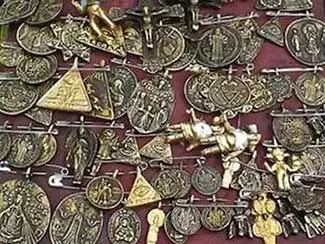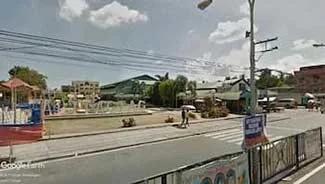Historical and Folkloric Notes about some Barrios of Alitagtag
This article is part of a series dedicated to historical and folkloric trivia about the barrios of Batangas Province. The information is taken from obscure documents submitted by Department of Education districts around the country in response to President Elpidio Quirino’s directive in the early 1950s to reconstruct local histories.
These local histories are archived at the National Library of the Philippines Digital Collections. If your barrio is not among those included, it could be that a) it was part of another barrio back in the fifties; b) no document was filed about it; or c) if there was a document submitted, it had been eaten away by time.
Alitagtag is a curious case because apart from a history of Alitagtag the town, there is a separate file of a barrio by the same name. I have asked people from Alitagtag, but nobody seems to know of a present barrio that was also formerly known as Alitagtag. I have come to the conclusion that this “Barrio Alitagtag” was, instead, the town center or poblacion. Hence, it is not included in this article. If anyone knows better, please enlighten us using the comments section at the bottom of this article.
To help any oldtimer who may stumble on this article, here is an excerpt from the document on “Barrio Alitagtag”: The name of the whole barrio was Alitagtag. However, different sections of the place had different names. Mrs. Dimaandal’s neighborhood was named Pitpitan… The present neighborhood of Mr. Enrique Rosales, the barrio lieutenant of that place, was called “Pinagtipacan.”
At any rate, here are the historic and folkloric notes about some barrios of Alitagtag:
Balagbag
In 1900, during the Philippine-American War, Filipino troops under one Capitan Alfonso Panopio, engaged and defeated American forces in a place called “Pulong Matanda,” presumably in the barrio. One enemy soldier escaped and rode back to the United States Army camp in Bauan to get reinforcements. Upon the arrival of more American troops, Panopio and company were forced to retreat. In retaliation, the Americans burned all the houses in Balagbag all the way to Cuta in Taal.
In 1945, when the whole of Alitagtag was declared a war zone, the Japanese forces had their headquarters in Barrio Balagbag. As American forces moved in from Nasugbu, the “Japanese soldiers stripped the inhabitants (of Balagbag) of their clothes, jewels, food and other supplies. The guerrillas were shot and the suspects were tortured to death.”
Source: History and Cultural Life of Barrio Balagbag
 |
| In 1900, Filipino revolutionaries engaged American forces in Balagbag. Image credit: Sandra Plummer Collection at the Fort Worth Library's Digital Archive. |
Concordia
Barrio Concordia used to be part of another barrio called Munlawin until it was separated in 1917. The barrio was supposedly named after the daughter of one Iñigo Arguelles, presumably one of Alitagtag’s prominent citizens at the time. During a meeting of town officials held in the home of Arguelles, the host was supposed to have instructed his daughter Concordia to “please get some cigarettes and let them (the officials) smoke.” Upon hearing the name, one official whose name was Raymundo Bautista supposedly called the others and suggested that the barrio be named after Arguelles’ daughter, since her name meant “unity1.” The others agreed and before long, the barrio was officially named Concordia.
Source: History and Cultural Life of Barrio Concordia
Dalipit
In the fifties, Dalipit East and Dalipit West used to be just one barrio named Dalipit. According to folklore, the barrio’s name was derived from the story of two boys who attempted to sneak into a woman’s garden. When the owner arrived and the boys attempted to escape, the foot of one of the boys was supposedly caught in the gate of the garden fencing. “Dali! Dali!,” the other boy cried. “Naipit!” replied the boy whose foot was caught in the gate.
The barrio was established between 1896 and 1900. Its original families were those of Juana de la Peña, Paula Bautista, Marcela de la Peña, Pedro Bautista and Ignacia Delgado, Benedicto de la Peña and Juana Gutierrez, Silvestre Catapang and Simplicia Malabanan, Nicolas de Ocampo and Fausta Bolor, Fausto Marquez and Catalina Marquez and Julian and Petra Bungo.
Source: History and Cultural Life of Barrio Dalipit
 |
| Dalipit was supposed to have gotten its name from the story of two boys who sneaked into somebody else's garden. Image credit: Aral Pinoy. |
Dominador
Just like Dalipit, there was just one barrio named Dominador back in the fifties. There were two versions of how the barrio got its name. The first said that the barrio was named after Dominador Gomez, a Filipino physician, labor leader and nationalist2. The other was a folkloric story about a man riding a cart who asked locals directions to the house of a Spaniard whose name was Dominador. The locals pointed him in the direction of the barrio, so each time he went and people asked him where he was going, he would reply, “Dominador.”
The barrio’s original families were those of Benito Manalo, Esteban Quitain, Gavino Aninao, Victoriano Basilan, Juan Ocampo, Severo Delgado, Pedro Marquez, Melencio Quitain, Alfonso Villanueva and Justo Catanyag.
Source: History and Cultural Life of Barrio Dominador
Munlawin
There was just one barrio named Munlawin back in the fifties. Regrettably, there were no records of the barrio when it was still part of Bauan. Hence, its date of founding cannot be established. According to folklore, the barrio’s name was taken from the molave tree, also known in Tagalog as molauin or molawin3. A man who went by the name of Anacleto was, according to folklore, supposed to have bought four molave posts to use for the building of his house, presumably in the barrio. As time passed by, he noticed “branches grew from one of the posts in the corner joint of the house.” Word spread around the barrio and people started to believe, for some reason, that the molave was the “strongest wood for any building purposes.” Presumably, because the storytelling of the fifties document leaves a lot to be desired, people in the barrio started to build their houses with molave wood.
Source: History and Cultural Life of Barrio Munlawin.
 |
| According to folklore, Munlawin obtained its name from the molave tree (above). Image credit: Philippine Medicinal Plants. |
Muzon First (Primero)
Muzon First used to be known as Mujon First. This is from the Spanish “mojon,” or a stone or heap of stones used as a landmark or boundary. The name was so given because the two barrios named Muzon were at the boundary of Alitagtag and Bauan. The barrio’s original families were those of Felix Abrenica, Nicolas Maranan, Mamerto Marquez, Ildefonso Baral, Eusebio Cabungcal and one Cabesang Talino.
In World War II, guerrillas operating in Muzon First threw a hand grenade at a passing jeep laden with Japanese soldiers. Unfortunately, they missed. The angry Japanese retaliated by burning all the houses in the barrio.
Source: History and Culture of Barrio Muzon First
Muzon Second (Segundo)
Muzon Second was established in 1860. The barrio would be known for a legendary bandit who presumably once lived there. His name was Roman Abratigue or, more fondly, as Romang Gabi. He was something of a Robin Hood figure in that he only stole from convents, and locals were supposed to have looked upon him fondly. He was said to have possessed an “anting-anting” called the “bungang kalog,” which protected him from bullets; and another called the “taga-bulag,” which rendered him virtually invisible to those who pursued him. Romang Gabi plundered towns around Batangas and even Mindoro until Spanish authorities finally caught up with him.
Source: History and Culture of Barrio Muzon Second
 |
| Romang Gabi of Muzon Second was believed to have carried various amulets. Image directly loaded from Wassup Pilipinas. |
2 “Dominador Gomez,” Wikipedia.
3 “Molave,” online at the Philippine Medicinal Plants.

